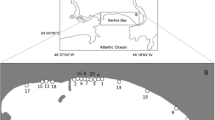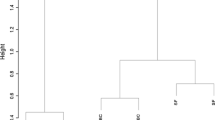Abstract
There is great inconsistency in the use of the terms ‘pulse’ and ‘press’ when describing types of perturbations. This is due primarily to a failure to distinguish between the cause and the effect of the perturbation in question. The cause and effect may be either short- or long-term and clearly one may be short-term and the other long-term. Distinction between these two types of disturbance is crucial for management to prevent further impact. Thus, it is important to describe separately these two aspects of a perturbation. Here, we define a protocol for sampling perturbations which enables the cause and effect to be distinguished between short- or long-term. Existing (i.e., already established) assemblages and newly-established assemblages are sampled and compared among disturbed and control locations. Existing assemblages may have been affected by past (pulse) disturbances and/or ongoing (press) disturbances, whereas the establishment of new assemblages can only be influenced by ongoing disturbances. We describe the procedures for assessing impacts of estuarine marinas as an illustration of the issues to be considered in any habitat. Settlement plates and defaunated sediment are suggested for sampling the establishment of new assemblages in aquatic environments.
Similar content being viewed by others
References
Ambrose, W. G.: 1984, ‘Influence of residents on the development of a marine soft-bottom community’, J. Mar. Res. 42, 633–654.
Andrew, N. L. and Mapstone, B. D.: 1987, ‘Sampling and the description of spatial pattern in marine ecology’, Ann. Rev. Oceanogr. Mar. Biol. 25, 39–90.
Auerbach, S. I.: 1981, ‘Ecosystem response to stress: a review of concepts and approaches’, In: Barrett, G. W. and Rosenberg, R. (eds.), Stress effects on natural ecosystems. John Wiley and Sons Ltd., Chichester, pp. 29–41.
Barrett, G. W. and Rosenberg, R.: 1981, Stress effects on natural ecosystems, John Wiley and Sons Ltd., Chichester.
Bender, E. A., Case, T. J. and Gilpin, M. E.: 1984, ‘Perturbation experiments in community ecology: theory and practice’, Ecology 65, 1–13.
Bernstein, B. B. and Zalinski, J.: 1983, ‘An optimum sampling design and power tests for environmental biologists’, J. Environ. Manage. 16, 335–343.
Butler, A. J.: 1991, ‘Effect of patch size on communities of sessile invertebrates in Gulf St Vincent, South Australia’, J. Exp. Mar. Biol. Ecol. 153, 255–280.
Connell, J. H.: 1978, ‘Diversity in tropical rainforests and coral reefs’, Science 199, 1302–1310.
Connell, J. H. and Sousa, W. P.: 1983, ‘On the evidence needed to judge ecological stability or persistence’, Am. Nat. 111, 1119–1144.
Dayton, P. K.: 1971, ‘Competition, disturbance and community organization: the provision and subsequent utilization of space in a rocky intertidal community’, Ecol. Monogr. 41, 351–389.
Detenbeck, N. E., DeVore, P. W., Neimi, G. J. and Lima, A.: 1992, ‘Recovery of temperate-stream fish communities from disturbance: a review of case studies and synthesis of theory’, Environ. Manage. 16, 33–53.
DeWitt, T. H. and Levinton, J. S.: 1985, ‘Disturbance, emigration, and refugia: how the mud snail, Ilyanassa obsoleta (Say), affects the habitat distribution of an epifaunal amphipod, Microdeutopus gryllotalpa (Costa)’, J. Exp. Mar. Biol. Ecol. 92, 97–113.
Fairweather, P. G.: 1990, ‘Sewage and the biota on seashores: assessment of impact in relation to natural variability’, Environ. Monit. Assess. 14, 197–210.
Fairweather, P. G. and Lincoln Smith, M. P.: 1992, ‘The difficulty of assessing environmental impacts before they have occurred: a perspective from Australian consultants’, In: Battershill, C. N. et al. (eds.), Proceedings of the Second International Temperate Reef Symposium. NIWA Marine, Wellington, pp. 121–130.
Frank, P. W.: 1968, ‘Life histories and community stability’, Ecology 49, 355–357.
Gallagher, E. D., Jumars, P. A. and Trueblood, D. D.: 1983, ‘Facilitation of soft-bottom benthic succession by tube builders’, Ecology 64, 1200–1216.
Gerritsen, J. and Patten, B. C.: 1985, ‘System theory formulation of ecological disturbance’, Ecol. Model. 29, 383–397.
Grassle, J. F. and Grassle, J. P.: 1974, ‘Opportunistic life histories and genetic systems in marine benthic polychaetes’, J. Mar. Res. 32, 253–284.
Green, R. H.: 1979, Sampling design and statistical methods for environmental biologists, Wiley Interscience, Chichester, England
Hollick, M.: 1986, ‘Environmental impact assessment: an international evaluation’, Environ. Manage. 10, 157–178.
Hurlbert, S. J.: 1984, ‘Pseudoreplication and the design of ecological field experiments’, Ecol. Monogr. 54, 187–211.
Kay, A. M. and Keough, M. J.: 1981, ‘Occupation of patches in the epifaunal communities on pier pilings and the bivalve Pinna bicolour at Edithburgh, South Australia’, Oecologia (Berl.) 48, 123–130.
Lake, P. S.: 1990, ‘Disturbing hard and soft bottom communities: a comparison of marine and freshwater environments’, Aust. J. Ecol. 15, 477–488.
Lenihan, H. S., Oliver, J. S. and Stephenson, M. A.: 1990, ‘Changes in hard bottom communities related to boat mooring and tributyltin in San Diego Bay: a natural experiment’, Mar. Ecol. Prog. Ser. 60, 147–159.
Lincoln Smith, M. P.: 1991, ‘Environmental impact assessment: the roles of predicting and monitoring the extent of impacts’, Aust. J. Mar. Freshwater Res. 42, 603–614.
McGuinness, K. A.: 1987, ‘Disturbance and organisms on boulders. I. Patterns in the environment and the community’, Oecologia (Berl.) 71, 409–419.
Miller, J. Z.: 1993, Assemblages associated with the tube-dwelling polychaete, Mesochaetopterus sagittarius, M.Sc. Thesis, University of Sydney, Sydney.
Morrisey, D. J. and Underwood, A. J.: 1992, ‘Sampling for spatial variation in the distribution of fauna in sediments’, In: Miskiewicz, A. G. (ed.), Proceedings of a bioaccumulation workshop: assessment of the distribution, impacts and bioaccumulation of contaminants in aquatic environments. Water Board and Australian Marine Sciences Association Inc., Sydney.
Murray, S. N. and Littler, M. M.: 1978, ‘Patterns of algal succession in a perturbated marine intertidal community’, J. Phycol. 14, 506–512.
Osenberg, C. W., Schmitt, R. J., Holbrook, S. J., Abu-Saba, K. E. and Flegal, R.: 1994, ‘Detection of environmental impacts: natural variability, effect size, and power analysis’, Ecol. Appl. 4, 16–30.
Osman, R. W.: 1977, ‘The establishment and development of a marine epifaunal community’, Ecol. Monogr. 47, 37–63.
Petraitis, P. S., Latham, R. E. and Niesenbaum, R. A.: 1989, ‘The maintenance of species diversity by disturbance’, Quart. Rev. Biol. 64, 393–418.
Pickett, S. T. A. and White, P. S.: 1985, The ecology of natural disturbance and patch dynamics, Academic Press, New York.
Pickett, S. T. A., Kolasa, J., Armesto, J. J. and Collins, S. L.: 1989, ‘The ecological concept of disturbance and its expression at various hierarchical levels’, Oikos 54, 129–136.
Probert, P. K.: 1984, ‘Disturbance, sediment stability, and trophic structure of soft-bottom communities’ J. Mar. Res. 42, 893–921.
Runkle, J. R.: 1985, ‘Disturbance regimes in temperate forests’, In: Pickett, S. T. A. and White, P. S. (eds.), The ecology of natural disturbance and patch dynamics. Academic Press, New York, pp. 17–33.
Russ, G. R.: 1980, ‘Effects of predation by fishes, competition, and the structural complexity of the substratum on the establishment of a marine epifaunal community’, J. Exp. Mar. Biol. Ecol. 42, 55–69.
Rykiel, E. J.: 1985, ‘Towards a definition of ecological disturbance’, Aust. J. Ecol. 10, 361–365.
Schroeter, S. C., Dixon, J. D., Kastendiek, J. and Smith, R. O.: 1993, ‘Detecting the ecological effects of environmental impacts: a case study of kelp forest invertebrates’, Ecol. Appl. 3, 331–350.
Selye, H.: 1973, ‘The evolution of a stress concept’, Am. Sci. 61, 692–699.
Sousa, W. P.: 1984, ‘The role of disturbance in natural communities’, Ann. Rev. Ecol. Syst. 15, 353–392.
Stewart-Oaten, A., Murdoch, W. M. and Parker, K. R.: 1986, ‘Environmental impact assessment: “pseudoreplication” in time?’, Ecology 67, 929–940.
Sutherland, J. P.: 1981, ‘The fouling community at Beaufort, North Carolina: a study in stability’, Am. Nat. 118, 499–519.
Sutherland, J. P. and Karlson, R. H.: 1977, ‘Development and stability of the fouling community at Beaufort, North Carolina’, Ecol. Monogr. 47, 425–446.
Thistle, D.: 1981, ‘Natural physical disturbances and communities of marine soft bottoms’, Mar. Ecol. Prog. Ser. 6, 223–228.
Underwood, A. J.: 1981, ‘Techniques of analysis of variance in experimental marine biology and ecology’, Ann. Rev. Oceanogr. Mar. Biol. 19, 513–605.
Underwood, A. J.: 1989, ‘The analysis of stress in natural populations’, Biol. J. Linn. Soc. 37, 51–78.
Underwood, A. J.: 1991, ‘Beyond BACI: experimental designs for detecting human environmental impacts on temporal variations in natural populations’, Aust. J. Mar. Freshwater Res., 42, 569–587.
Underwood, A. J.: 1992, ‘Beyond BACI: the detection of environmental impact on populations in the real, but variable, world’, J. Exp. Mar. Biol. Ecol. 161, 145–178.
Underwood, A. J.: 1993, ‘The mechanics of spatially replicated sampling programmes to detect environmental impacts in a variable world’, Aust. J. Ecol. 18, 99–116.
Underwood, A. J.: 1994, ‘On beyond BACI: sampling designs that might reliably detect environmental disturbances’, Ecol. Appl. 4, 3–15.
Watt, A. S.: 1947, ‘Pattern and process in the plant community’, J. Ecol. 35, 1–22.
Yodzis, P.: 1988, ‘The indeterminacy of ecological interactions as perceived through perturbation experiments’, Ecology 69, 508–515.
Author information
Authors and Affiliations
Rights and permissions
About this article
Cite this article
Glasby, T.M., Underwood, A.J. Sampling to differentiate between pulse and press perturbations. Environ Monit Assess 42, 241–252 (1996). https://doi.org/10.1007/BF00414371
Received:
Revised:
Issue Date:
DOI: https://doi.org/10.1007/BF00414371




